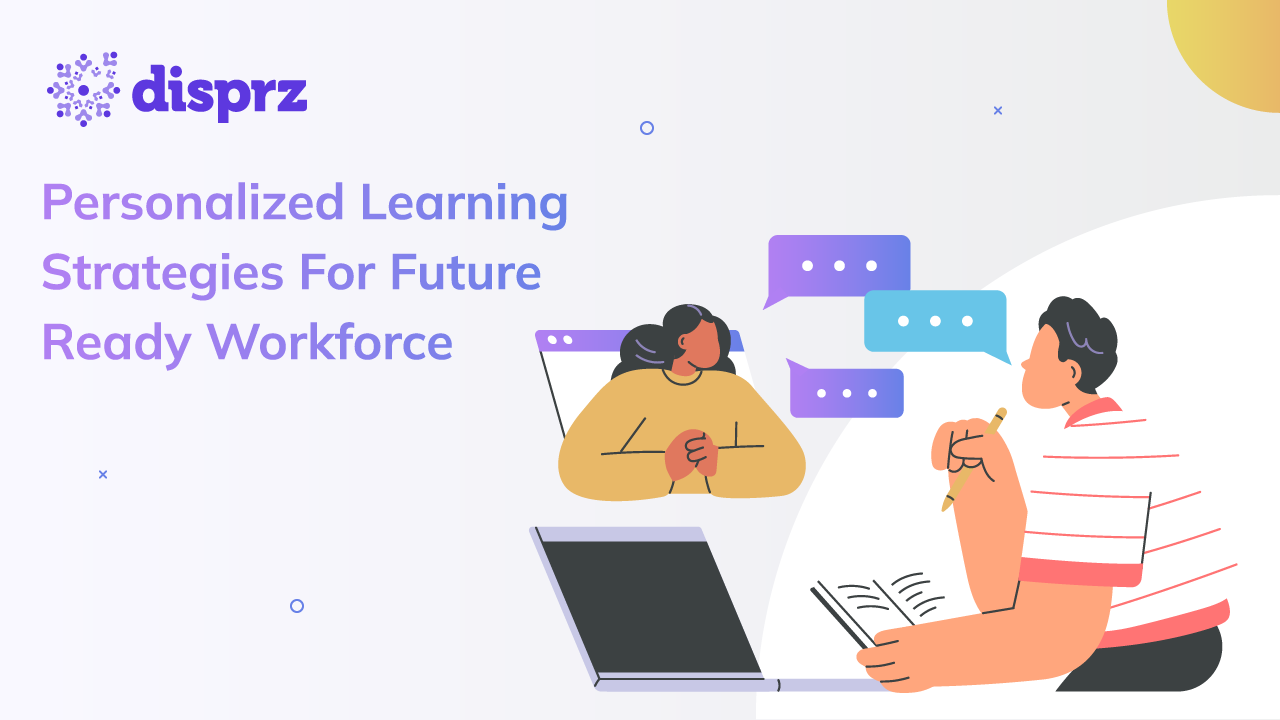For decades, organizations grappled with the limitations of conventional, one-size-fits-all learning methods that struggled to meet the diverse needs and evolving skill requirements of their workforce.
The inadequacies of traditional learning approaches became apparent as businesses witnessed diminishing returns on their learning investments. On average, companies spent $1,280 per employee on learning and development, yet only 12% of employees applied the acquired skills to their roles effectively. This discrepancy underscored a fundamental issue – the failure of standardized training methods to yield tangible returns and drive business success.
However, the paradigm shift towards personalized learning has sparked a revolution in workforce skill development, heralding a new era of tailored and impactful learning experiences. Recent research found that 93% of high-performing organizations agreed personalized learning supports an employee in reaching professional goals more efficiently, leading to better employee engagement.
In this , let's explore the personalized learning strategies that organizations can implement to create a dynamic and engaging learning culture that not only meets the unique needs of their workforce but also drives continuous skill enhancement and professional growth.
What is Personalized Learning?
Personalized learning is a learner-centric L&D approach that prioritizes the individual's unique learning needs and interests. Successful organizations worldwide attribute their workforce's success to the implementation of precise personalized learning strategies.
Research indicates that leading organizations prioritize employee development by providing an average of about 75 hours of training per employee annually. Such investments not only foster a culture of continuous learning but also result in higher promotion rates and increased employee retention.
Introducing personalized learning within organizations extends beyond enhancing employee engagement; it serves as a catalyst for driving efficiency, productivity, and seamless alignment with organizational goals. As a result, it emerges as an indispensable element for any progressive organization's learning and development initiatives, ensuring that individual growth resonates with the collective success of the company.
Importance of Personalized Learning in the Modern Workforce
In today's knowledge-based economy, where technological advancements and market dynamics continuously reshape industries, the ability to acquire new skills and adapt swiftly is crucial. As such, personalized learning emerges as a linchpin for empowering employees to thrive in this fast-paced environment. It not only addresses the diverse learning preferences within a workforce but also aligns with the demands of a highly competitive and innovation-driven market.
By tailoring learning experiences to individual needs and preferences, personalized learning stands as a catalyst for workforce success. It fosters a culture of continuous learning, enhances employee engagement and motivation, and equips individuals with the skills needed to navigate an ever-evolving professional landscape. Moreover, it plays a pivotal role in empowering employees to take charge of their own development, contributing to a more skilled, adaptable, and resilient workforce.
Personalized Learning Strategies to Drive Employee Performance and Workforce Success
Low completion rate, learner disengagement, poor performance, and a low level of L&D adoption are some of the most common challenges that companies face when implementing an employee learning program. Sadly, traditional learning strategies aren’t effective in the modern world of Netflix and Amazon where people have become accustomed to receiving personalized recommendations. Employees expect the same personalization throughout their learning and development journey.
Today’s employees are interested in a “just for me” learning style. Something that one employee finds useful won’t necessarily be helpful for the others. Their problem areas might differ. Here are key personalized learning strategies to ensure you provide an effective customized learning experience for your employees.
Align learning and business objectives
Prior to embarking on the personalized learning journey, it's essential to align learning goals with overarching business objectives, serving as benchmarks to gauge progress. Defining clear objectives is paramount before delving into tailored learning experiences for specific departments or roles.
To effectively establish these goals, collaborate closely with business leaders to comprehend the strategic aims of each department. Simultaneously, engage with team leaders to delineate individual learning objectives within these departments. This alignment ensures that personalized learning initiatives resonate with and contribute directly to achieving overarching business outcomes.
Create a Skill inventory
Creating a skills inventory is imperative for the success of personalized learning initiatives. This comprehensive process involves cataloging and evaluating the existing skill sets within an organization. This inventory not only identifies the skills employees currently possess but also highlights the reskilling requirments. It enables organizations to strategically align learning programs with specific skill deficiencies, tailoring content and resources to address these gaps effectively.
Here are a few steps to building a skill inventory.
Identify industry-relevant skills
Research industry standards and consider the specific needs of your business. List skills that align with your business objectives, diverse projects, and key areas of each role within the organization.
Categorize skills
Technical skills
Include role-specific technical competencies relevant to the job function or industry.
Functional skills
Encompass broader functional capabilities applicable across various tasks and roles.
Leadership skills:
Highlight skills related to leadership, management, communication, and decision-making for managerial or supervisory roles.
Grade skill levels
Utilize a numbered scale (e.g., Novice to Expert) to assess proficiency levels for each skill category. Assign a level to indicate the degree of proficiency an individual possesses in a particular skill.
Perform skill research
Manually conduct research to identify and benchmark skills required for each role within your organization. This involves analyzing job descriptions, industry reports, and expert insights to compile a comprehensive skills inventory.
Consider leveraging advanced learning technology like a Learning Experience Platform (LXP), such as Disprz LXP to expedite the process. LXPs can aid in skill identification, benchmarking, and aligning skills with specific roles more efficiently. Utilizing such platforms can streamline data gathering, skill evaluation, and alignment with industry standards.
Discover individual employee skills gap
To build a successful personalized learning experience for your employees, it is important to have a holistic view of each employee’s learning needs and skills gap. Start the process by determining the skills that are essential for a specific job role. Then determine if an employee possesses these skills. This process can be simplified by leveraging a skilling suite, such as Disprz that aids in role-based benchmarking.
Once you complete the skill assessment of each employee, you must map them to the skills you have identified as being most important for a specific job role. You can use a skill score here that will help you understand how strong an employee is in a particular skill and which skills they are missing.
Once you’ve implemented this learning strategy, design a personalized learning program for each employee. Invest time in planning the courses required for skill development The more energy you put into personalizing learning the better results you will get to see.
Leverage AI to personalize the learning experience
Implementing the right personalized learning objectives will change the game when it comes to employee learning. So, it's important to be extra careful when implementing an employee upskilling and learning platform.
An employee Learning Experience Platform (LXP) powered with AI capabilities can be your helping hand in this personalized approach for your employee learning experiences.
AI helps in creating personalized learning pathways tailored to each individual’s specific needs. AI-based recommendations facilitate on-demand learning. Content is suggested based on an employee’s learning interest, learning history, and job role. It gives learners the control to access learning material at their pace and convenience. AI not only aligns learning with an individual’s performance goals but also allows you to predict course maps and make relevant changes in real time.
Read how Deloitte leveraged Disprz AI-powered learning experience platform to automate learning journeys, personalize employee onboarding experiences, and achieved a 95% course completion rate.
Embrace multi-format microlearning
Some employees like to learn by watching videos, some by listening to podcasts, and others by reading content. Embracing a multi-format blended learning style is a personalized learning strategy that gives your learners the flexibility to choose how they want to learn. Use videos, podcasts, and various forms of bite-sized, engaging content.
Microlearning is a great way to personalize learning. Through mobile learning, you give them the flexibility to learn what they want, whenever they want. The bite-sized content seamlessly merges into the flow of work. This has a positive impact on the completion ratio. Learners are getting the information they need at the right time and place so they feel motivated to complete the courses.
Learning can even be personalized by adding the fun element through gamification. The gamified approach is highly engaging and effective especially when it is clubbed with personalization.
Studies found that 90% of employees feel more productive when using gamification.
By offering a diverse array of learning formats, leveraging microlearning, and incorporating gamification, organizations can create an environment where learning is not only tailored to individual preferences but is also enjoyable and effective.
Involve managers in the learning process
Engaging managers in the learning process presents an untapped resource for tailoring personalized learning journeys. Managers possess invaluable insights about their teams, making their involvement crucial for successful learning initiatives. However, gaining their cooperation and participation is key to leveraging this resource effectively.
Foster collaboration with managers and integrate them into the learning ecosystem. Seek their input regarding employees' strengths and areas needing improvement.
By partnering with managers, identify the most suitable courses and learning pathways that align with employees' development needs. Leveraging their firsthand knowledge, design impactful learning programs that employees will enthusiastically engage with to enhance their skills.
Continuous feedback and adaptation
Foster a culture of continuous feedback and adaptation in personalized learning programs. Encourage employees to provide feedback on their learning experiences, allowing for adjustments and improvements in learning approaches.
Regularly evaluate the effectiveness of personalized learning strategies through feedback mechanisms, assessments, and analytics. Use these insights to refine and optimize learning initiatives for better outcomes.
Conclusion
Organizations have journeyed from the limitations of traditional learning approaches to embracing the transformative potential of AI-powered personalized learning. The shift signifies a profound change, recognizing the imperative to cater to individual employee needs and preferences. Today, progressive organizations understand that an advanced Learning Experience Platform (LXP), such as Disprz, offers a gateway to not just engagement but also enhanced business success and return on investment (ROI).
Disprz LXP offers tailored learning pathways unique to each individual, leveraging AI capabilities to curate content aligned with employees' learning history, interests, and job roles. Disprz seamlessly integrates multi-format microlearning, enabling employees to learn at their own pace through videos, podcasts, and bite-sized content that effortlessly integrates into their workflow.
In today's era of dynamic learning, embracing advanced LXPs like Disprz isn't just a choice; it's a necessity for organizations seeking to drive better employee engagement, foster business success, and achieve substantial returns on their learning investments.
Are you seeking a solution that transforms learning experiences and drives organizational success?
Book a demo with Disprz today and witness the power of AI-driven personalized learning in action!










